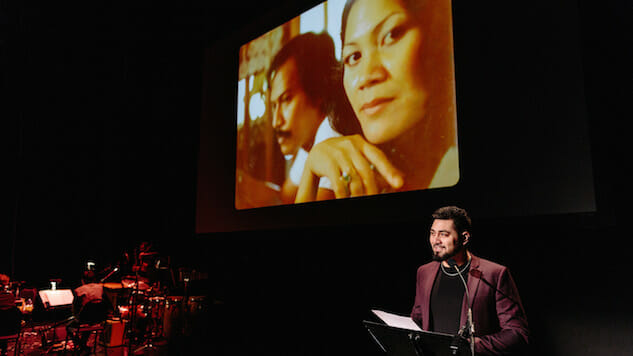The Medium of Liveness: How Pop-Up Magazine Plans to Transform Journalism
Photo: Erin Brethauer
Jon Mooallem is trying, too fast, to describe his own face. Well, sort of: The visage in question belongs, in fact, to Manolete, the famed matador of Franco’s Spain, though the two men bear such close resemblance that Mooallem himself might be trapped in the ’40s, dressed in the bullfighter’s ornate regalia. I’ve dropped in on the sound check for Pop-Up Magazine’s one-night-only appearance at New Orleans’ Civic Theatre, and from the front row this is the note I hear from senior producers Anita Badejo and Haley Howle as Mooallem, writer at large for The New York Times Magazine, crouches to listen at the end of the stage: Too fast. It’s a lovely yarn, toggling between Mooallem and Manolete; it’s self-deprecating but circumspect, with a slight sorrowful edge. And yet, without the drama of an audience—that thrum of expectation that passes from patron to performer—the segment loses air as it goes along. Without the drama of an audience, it’s not Pop-Up Magazine.
First held at San Francisco’s Mission Theatre in 2009, before graduating to the 3,000-seat Symphony Hall and thence onto the road, Pop-Up Magazine styles itself a “live magazine.” Its subject matter is that of a general interest publication—remote islands off the coast of the Korean Peninsula; the future of elder care; New Orleans’ black-owned bars—re-imagined as a series of multimedia stories—a concert, a play, a movie, a podcast, and a magazine “all mixed together,” as co-founder and editor in chief of Pop-Up Magazine and The California Sunday Magazine Douglas McGray describes it. It even features ads: a Candid Camera-inspired commercial for the “connected home device” company Nest; a Coach-sponsored New Orleans travelogue; a trailer for Amazon Studios’ coming attractions. But the operative part of “live magazine,” in Pop-Up’s case, isn’t “magazine.”
It’s “live.”
“We consider liveness to be its own medium,” Badejo says, speaking over the ambient noise of karaoke classics in an anteroom backstage. By this, as it happens, she does not mean simply that contributor and “reader” are in the room together. That segment on elder care? It’s Rose Eveleth’s choose-your-own-adventure speculative fiction, in which the audience participates by holding up glow sticks. Those overplayed ditties being rehearsed on stage? They’re for Brittany Spanos’ piece on “the top five most dangerous karaoke songs,” culminating in a full-theatre sing-along to Journey’s “Don’t Stop Believin’.” “We’re looking for what we call ‘magic moments,’” Badejo continues. “Surprises that can only happen because our show is live and because it’s on a stage and because we go to the cities that we go to.”
In New Orleans, this site-specific approach assumes the form of L. Kasimu Harris’ loving photographic tour, “In the Barroom,” and novelist Nathaniel Rich’s tale of the infamous Axeman serial killer and the popularization of jazz. (When I meet Rich, a longtime New Orleans resident, earlier in the day, he explains that his Pop-Up Magazine segment is drawn from historical research he conducted for his new novel, King Zeno, albeit without fiction’s embellishments: “In the novel, I solve the Axeman case,” he laughs. “Which has not been solved in real life.”) In this, an “issue” of Pop-Up, which changes slightly with every stop on its mutli-city tour, is the very opposite of a magazine: Its stories are ephemeral, physically speaking, in a way the California Sunday’s are not.
That’s not to say they’re forgettable—Eric Eddings and Brittany Luse’s riotously funny “Scene from a Popeyes,” which deconstructs the genre they call “Black history art” and pieces it back together with help from Oprah, Beyoncé, James Baldwin, Ida B. Wells, Kanye West, Serena Williams, and illustrator Shyama Golden, is one I’ve been describing to friends since Friday night’s performance. As McGray suggests, contrasting Pop-Up which a digital news item you open and close, half-finished, while waiting in line for coffee, having a link (or a print edition) at one’s fingertips is no guarantee that the stories therein are durable.
-

-

-

-

-

-

-

-

-

-

-

-

-

-

-

-

-

-

-

-

-

-

-

-

-

-

-

-

-

-

-

-

-

-

-

-

-

-

-

-








































